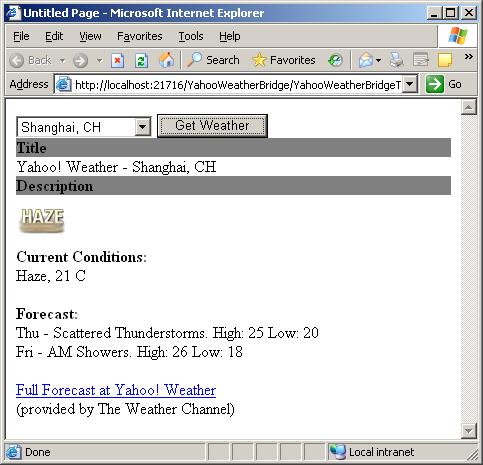在ASP.NET Atlas中调用Web Service——创建Mashup调用远端Web Service(Yahoo!天气实例)
在前一篇文章(在ASP.NET Atlas中调用Web Service——创建Mashup调用远端Web Service(基础知识以及简单示例))中,我介绍了一些Atlas中对远程Web Service进行Mashup的基础知识,并给出了一个最基础的没有丝毫用处例子。今天再回到这个话题上,我将给出一个更复杂点的,但有一些用处的例子——Yahoo! Weather。
废话到此为止,让我们先熟悉一下Yahoo! Weather服务:Yahoo!在其网站上提供了天气预报服务(http://weather.yahoo.com/),并且它也提供了Web Service的接口(http://developer.yahoo.com/weather/)
从上面两个网页上面,我们可以知道Yahoo!提供的天气Service的URL为http://xml.weather.yahoo.com/forecastrss,该服务还有两个参数:
- p:要查询天气的地点代码(可以在http://weather.yahoo.com/查询到不同地方的这个代码)。
- u:返回结果中温度的单位,f代表华氏度,c代表摄氏度。
看来这个Yahoo! Weather服务还挺简单的,让我们测试下好不好用。先到http://weather.yahoo.com/查出来上海的地点代码为CHXX0116。然后在浏览器中输入http://xml.weather.yahoo.com/forecastrss?p=CHXX0116&u=c,嗯,返回了如下的一段不是很复杂的XML:
我们可以看到,它提供的信息非常全面(连日出日落时间都有……),下面让我们书写asbx Bridge页面来对这个Service进行Mashup。
首先,参考在ASP.NET Atlas中调用Web Service——创建Mashup调用远端Web Service(基础知识以及简单示例)这篇文章中的那个asbx的声明,我们可以写出如下一段:
 <?xml version="1.0" encoding="utf-8" ?>
<?xml version="1.0" encoding="utf-8" ?> <bridge namespace="Dflying" className="YahooWeatherService">
<bridge namespace="Dflying" className="YahooWeatherService">
 <proxy type="Microsoft.Web.Services.BridgeRestProxy"
<proxy type="Microsoft.Web.Services.BridgeRestProxy"  serviceUrl="http://xml.weather.yahoo.com/forecastrss" />
serviceUrl="http://xml.weather.yahoo.com/forecastrss" />
 <method name="GetWeather">
<method name="GetWeather"> <input>
<input> <parameter name="p" />
<parameter name="p" /> <parameter name="u" value="c" />
<parameter name="u" value="c" /> </input>
</input> </method>
</method> </bridge>
</bridge>
其中:
- <bridge>的namespace和className属性以及<method>的name属性让我们在客户端JavaScript中可以通过Dflying.YahooWeatherService.GetWeather()这样的方法签名来访问这个Mashup。
- <proxy>的serviceUrl属性指定了Yahoo! Weather Service的URL。
- GetWeather方法中定义了上面列出来的p和u两个参数,其中u参数我们指定了它的默认值为c(代表摄氏度),p参数将由调用者负责传过来。
写到这一步其实也够了,客户端将收到上面浏览器中看到的那一段XML String,并且可以在客户端进行处理并显示。但客户端对XML的处理并不是那么容易,也不是那么高效,同时通过网络传输太多不必要的信息也是一种浪费。所以这里我们利用asbx中内建的Transformer对这段XML处理一下,提取出我们感兴趣的内容并以JSON的形式发给客户端。在<method>段中加入下面一段:
 <transforms>
<transforms> <transform type="Microsoft.Web.Services.XPathBridgeTransformer">
<transform type="Microsoft.Web.Services.XPathBridgeTransformer"> <data>
<data> <attribute name="selector" value="channel" />
<attribute name="selector" value="channel" /> <dictionary name="namespaceMapping">
<dictionary name="namespaceMapping"> <item name="yweather" value="http://xml.weather.yahoo.com/ns/rss/1.0" />
<item name="yweather" value="http://xml.weather.yahoo.com/ns/rss/1.0" /> </dictionary>
</dictionary> <dictionary name="selectedNodes">
<dictionary name="selectedNodes"> <item name="Title" value="title" />
<item name="Title" value="title" /> <item name="Description" value="item/description" />
<item name="Description" value="item/description" /> <item name="CurrentCondition" value="item/yweather:condition/@text" />
<item name="CurrentCondition" value="item/yweather:condition/@text" /> </dictionary>
</dictionary> </data>
</data> </transform>
</transform> </transforms>
</transforms>
其中<transforms>声明表示这个Mashup方法的返回值将会被一些transformer改变一下,里面声明了一个类型为Microsoft.Web.Services.XPathBridgeTransformer的transformer,表示将用XPath表达式来转换。在这个XPathBridgeTransformer中要声明如下部分:
- name为selector的一个attribute段,其中指定的value属性为一个XPath表达式,将选取整个XPathBridgeTransformer将用到的数据段。
- name为namespaceMapping的一个dictionary段,其中指定了这个XML文件中的namespace映射。如果在下面的选择节点过程中我们用到了某个namespace,那么这里就必须有它的声明。这里我们在其中添加一个对yweather的映射,因为下面要用到。
- name为selectedNodes的一个dictionary段,其中每一个item的value属性是一个XPath String,用来从XML中选择出相应的值,name属性用来指定相应的在JavaScript中的属性名称。这里作为示例,我只取得其中三段内容,您可以看到,其中CurrentCondition的XPath中用到了上面指定的namespaceMapping。
关于XPath的知识,我就不多讲了,感兴趣或是不太熟悉的朋友可以自行Google,网上资源很多。关于其他类型的Transformer,我也不是很熟悉,今后如果遇到了我再讲讲。完成后的YahooWeatherBridge.asbx文件如下:
 <?xml version="1.0" encoding="utf-8" ?>
<?xml version="1.0" encoding="utf-8" ?> <bridge namespace="Dflying" className="YahooWeatherService">
<bridge namespace="Dflying" className="YahooWeatherService">
 <proxy type="Microsoft.Web.Services.BridgeRestProxy"
<proxy type="Microsoft.Web.Services.BridgeRestProxy"  serviceUrl="http://xml.weather.yahoo.com/forecastrss" />
serviceUrl="http://xml.weather.yahoo.com/forecastrss" />
 <method name="GetWeather">
<method name="GetWeather"> <input>
<input> <parameter name="p" />
<parameter name="p" /> <parameter name="u" value="c" />
<parameter name="u" value="c" /> </input>
</input> <transforms>
<transforms> <transform type="Microsoft.Web.Services.XPathBridgeTransformer">
<transform type="Microsoft.Web.Services.XPathBridgeTransformer"> <data>
<data> <attribute name="selector" value="channel" />
<attribute name="selector" value="channel" /> <dictionary name="namespaceMapping">
<dictionary name="namespaceMapping"> <item name="yweather" value="http://xml.weather.yahoo.com/ns/rss/1.0" />
<item name="yweather" value="http://xml.weather.yahoo.com/ns/rss/1.0" /> </dictionary>
</dictionary> <dictionary name="selectedNodes">
<dictionary name="selectedNodes"> <item name="Title" value="title" />
<item name="Title" value="title" /> <item name="Description" value="item/description" />
<item name="Description" value="item/description" /> <item name="CurrentCondition" value="item/yweather:condition/@text" />
<item name="CurrentCondition" value="item/yweather:condition/@text" /> </dictionary>
</dictionary> </data>
</data> </transform>
</transform> </transforms>
</transforms> </method>
</method> </bridge>
</bridge>
现在创建一个ASP.NET Page测试一下,首先依然是重复了一千遍的ScriptManager,还有对Bridge的引用:
 <atlas:ScriptManager ID="sm" runat="server">
<atlas:ScriptManager ID="sm" runat="server"> <Services>
<Services> <atlas:ServiceReference Path="YahooWeatherBridge.asbx" />
<atlas:ServiceReference Path="YahooWeatherBridge.asbx" /> </Services>
</Services> </atlas:ScriptManager>
</atlas:ScriptManager>然后一个HTML Select元素,里面列入了几个城市以及相应的城市代码:
 <!-- place selector -->
<!-- place selector --> <select id="place">
<select id="place"> <option selected="selected" value="CHXX0116">Shanghai, CH</option>
<option selected="selected" value="CHXX0116">Shanghai, CH</option> <option value="USCA0746">Mountain View, CA</option>
<option value="USCA0746">Mountain View, CA</option> <option value="CHXX0008">Beijing, CH</option>
<option value="CHXX0008">Beijing, CH</option> </select>
</select>一个HTML Button,用来触发对Service的调用:
 <!-- invoke the service -->
<!-- invoke the service --> <input id="getWeather" type="button" value="Get Weather" onclick="return getWeather_onclick()" />
<input id="getWeather" type="button" value="Get Weather" onclick="return getWeather_onclick()" />一段HTML用来显示结果:
 <!-- display result -->
<!-- display result --> <div id="result" style="display: none;">
<div id="result" style="display: none;"> <div style="background-color: Gray; font-weight: bold;">Title</div>
<div style="background-color: Gray; font-weight: bold;">Title</div> <div id="title"></div>
<div id="title"></div> <div style="background-color: Gray; font-weight: bold;">Description</div>
<div style="background-color: Gray; font-weight: bold;">Description</div> <div id="description"></div>
<div id="description"></div> </div>
</div>
然后是JavaScript,可以看到通过Dflying.YahooWeatherService.GetWeather()调用了Mashup,并在方法返回后把经过transform的值输出到了页面上:
 function getWeather_onclick() {
function getWeather_onclick() { // new atlas 'Select' control
// new atlas 'Select' control var place = new Sys.UI.Select($('place'));
var place = new Sys.UI.Select($('place'));
 // invoke the bridge method
// invoke the bridge method Dflying.YahooWeatherService.GetWeather({'p': place.get_selectedValue()}, onGetComplete);
Dflying.YahooWeatherService.GetWeather({'p': place.get_selectedValue()}, onGetComplete); }
} function onGetComplete(result) {
function onGetComplete(result) { $('result').style.display = "block";
$('result').style.display = "block"; $('title').innerHTML = result[0].Title;
$('title').innerHTML = result[0].Title; $('description').innerHTML = result[0].Description;
$('description').innerHTML = result[0].Description; }
}最后浏览器中看一下结果,上海天气:
Mountain View天气:
该实例程序的源代码可以在此下载:https://files.cnblogs.com/dflying/YahooWeatherBridge.zip







